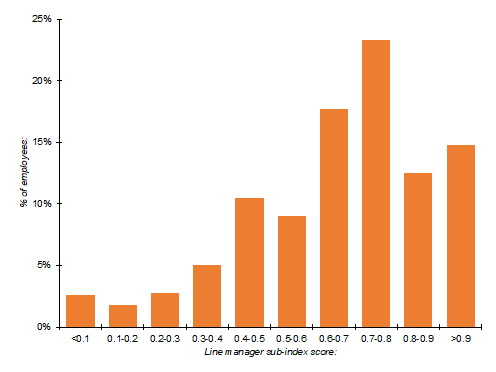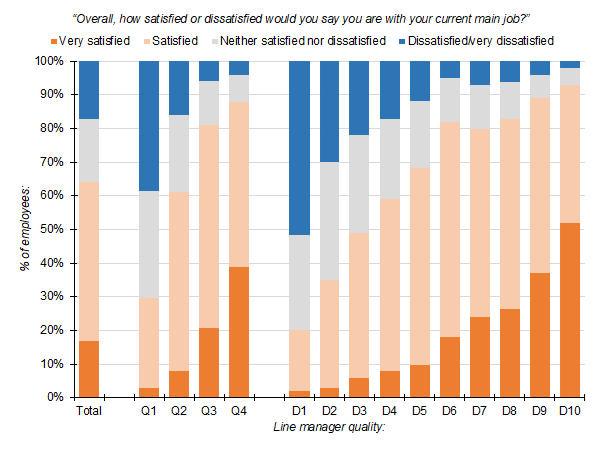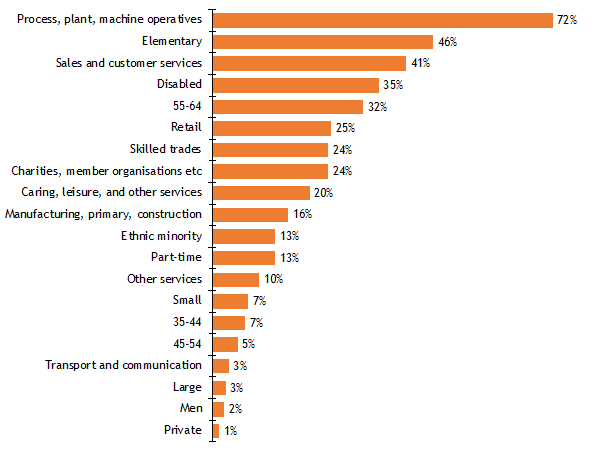Last month, the CIPD published The importance of people management: Analysis of its impact on employees which showed just how much difference the quality of people management made to employee performance, health and wellbeing. To quote just one set of figures, half of employees with the lowest-scoring quarter of line managers said they thought work made their mental health worse, compared with just 14% for employees with the highest-scoring quarter of people managers.
“If people think you’re a bad boss, odds are you are a bad boss
What does the CIPD Good Work Index (GWI) show?
The measure of line manager quality used was constructed for the GWI. It is based on nine questions employees were asked about their line manager, which together amount to the basics of trustworthiness (questions of competence such as whether they provide constructive feedback as well as questions of integrity such as whether they treat employees fairly and with respect). The measure runs from zero (complete lack of trust, felt by 1% of employees), to one (complete trust, 8% of employees) as shown in Figure 1.
Figure 1 Distribution of line manager sub-index scores, 2022
(UK, excluding self-employed, owners/proprietors or partners in a business, and those who don’t have a line manager)

Source: CIPD/YouGov UK Working Lives survey 2022.
This measure is indirect – data was collected on the employees’ views of their line managers, rather than on the (anonymous) managers themselves. The measure is also a collation of subjective opinions – no one moderates them or second-guesses the employee. In particular, there is no attempt to measure 'management style'. For example, should someone who gets results by shouting and swearing be 'marked down' for failing to treat their employees with respect? The Economist’s Bartleby columnist, at the height of the Dominic Raab affair, had a very good answer: "if enough people think you are a bad boss, you are a bad boss." Lack of trust in your manager can produce results but possibly only in the short-term and at a price in morale, health and wellbeing. This is reflected in the end by employees voting with their feet.
The bottom 10%
For the report, we divided employees into four groups, depending purely on their line manager score, and compared them to each other. The choice of four groups was to make comparisons simple and meaningful. But other ways of slicing the data are possible. Figure 2 shows what happens if we also cut the data into ten deciles.
Figure 2 Job satisfaction by line manager sub-index score, 2022
(UK, excluding self-employed, owners/proprietors or partners in a business, and those who don’t have a line manager)

Source: CIPD/YouGov UK Working Lives survey 2022.
In total, 64% were satisfied with their job (sum of orange bars, total column). This varied from 30% with the lowest-ranked quarter to 88% with the highest-ranked quarter (columns Q1 to Q4). Cutting the data into ten, the variation is from 20% to 93% (columns D1 to D10). Furthermore, these data on job satisfaction are typical of what is a more general trend: bad outcomes at the bottom of the line manager distribution are not matched by good outcomes at the top. In other words, moving an employee’s manager up from the bottom 10% to the next-worst 10% tends to have a greater (positive) impact than moving an employee’s (already good) manager up from the next-best 10% to the top decile.
Who’s in the bottom 10%?
Figure 3 shows which types of work and workplace are over-represented in the bottom 10%.
Figure 3 Over-representation in the bottom 10%, 2022
(UK, excluding self-employed, owners/proprietors or partners in a business, and those who don’t have a line manager)

Source: CIPD/YouGov UK Working Lives survey 2022.
We need to remember that these refer to the characteristics of the employee. It’s the managers of people doing routine jobs who are over-represented in the 10% worst managers, not the people doing those jobs. And the over-representation of the disabled, older workers (age 55–64), ethnic minorities, and employees working part-time hours doesn’t mean their managers are necessarily bad managers. It means, though, that they are not good managers for these employees. Other research suggests that training in people management can raise a manager’s competence and confidence, yet only just over half of managers think they are given the information and training they need. Better trained (and better supported) people managers are key to raising management behaviour at the bottom.
Topics A-Z
Browse our A–Z catalogue of information, guidance and resources covering all aspects of people practice.
Bullying
and harassment
Discover our practice guidance and recommendations to tackle bullying and harassment in the workplace.
About the author

Mark Beatson, Senior Labour Market Analyst
Mark's respected labour market analysis and commentary strengthens the CIPD’s ability to lead thinking and influence policy making across the whole spectrum of people management and workplace issues.
Prior to joining the CIPD, Mark was an economic consultant and for over 20 years worked as an economist in the Civil Service, latterly at Chief Economist/Director level, in a range of Government departments including the Department for Business Innovation and Skills (BIS), the Department for Innovation, Universities and Skills (DIUS), the Department of Trade and Industry (DTI) and HM Treasury.

Read the CIPD’s November 2023 submission to His Majesty’s Treasury

Employers need to be ready to protect employees from sexual harassment under a new statutory obligation

Peter Cheese, the CIPD's chief executive, looks at the challenges and opportunities faced by today’s business leaders and the strategic priorities needed to drive future success

We outline the key pieces of legislation set to come into force in the UK and explain their implications for employers and employees

We examine people’s desired hours and how this compares to the hours they actually work

